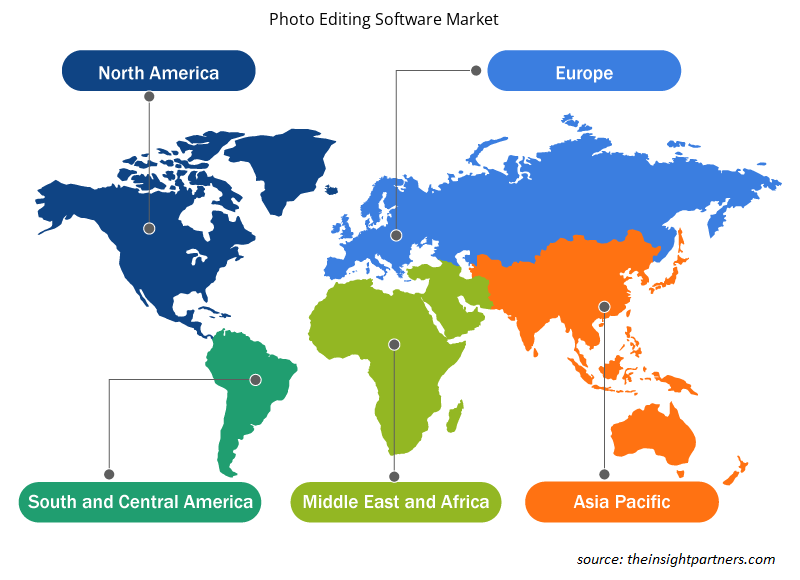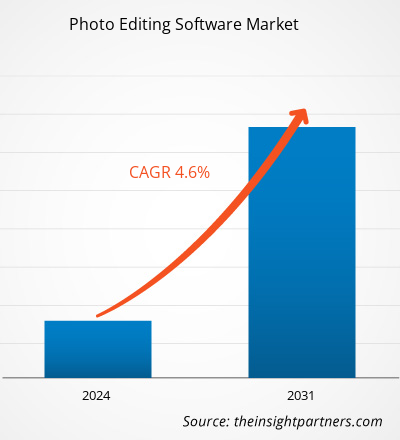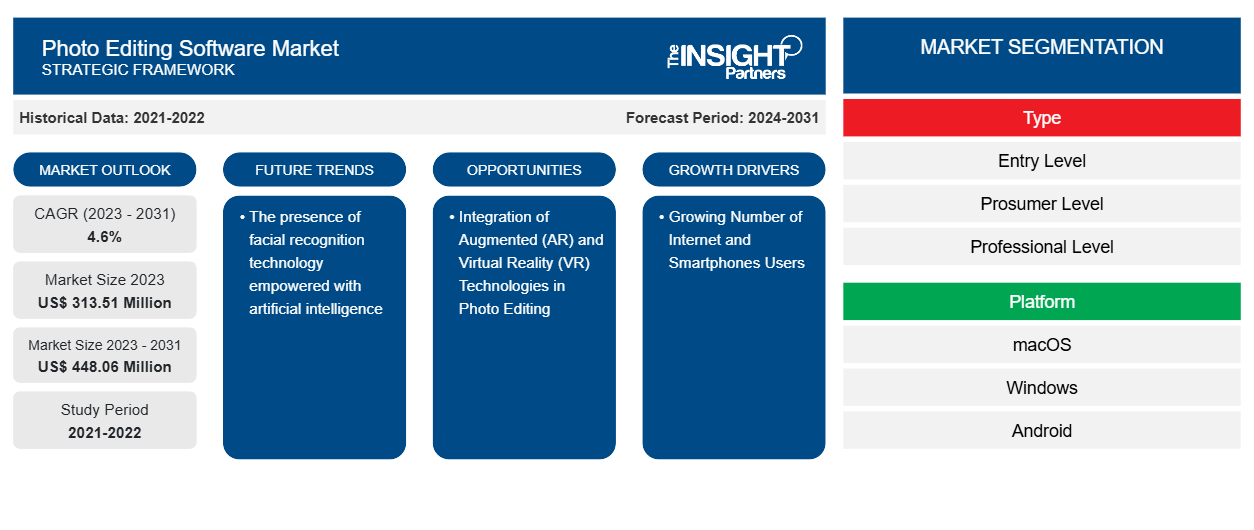Se prevé que el tamaño del mercado de software de edición de fotografías alcance los 448,06 millones de dólares en 2031, frente a los 313,51 millones de dólares en 2023. Se espera que el mercado registre una CAGR del 4,6 % entre 2023 y 2031. Es probable que la presencia de tecnología de reconocimiento facial potenciada con inteligencia artificial siga siendo una tendencia clave en el mercado de software de edición de fotografías.
Análisis del mercado de software de edición de fotografías
El mercado de software de edición de fotografías está creciendo a un ritmo rápido debido al creciente número de usuarios de Internet y de teléfonos inteligentes y a la creciente demanda de fotografías digitales entre los consumidores. El mercado se está expandiendo de manera constante, impulsado por la creciente necesidad de imágenes de calidad de alta definición para usos individuales y comerciales. Además, la integración de tecnologías de realidad aumentada (RA) y realidad virtual (RV) en la edición de fotografías y el uso creciente de algoritmos computacionales en el software de edición de fotografías están brindando oportunidades lucrativas para el crecimiento del mercado.
Descripción general del mercado de software de edición de fotografías
El software de edición de fotografías es una aplicación de fotografía digital que permite a los usuarios recortar, reparar y organizar sus fotografías según sus necesidades. El software puede tomar fotografías escaneadas de fotografías en película antiguas y convertirlas en imágenes digitales. Estas imágenes se restauran digitalmente eliminando defectos y mejorando la calidad de la imagen. La demanda de efectos especiales en las fotografías, incluidos el color, los tintes, la orientación de la imagen, las fotografías digitales y la edición por capas, entre otros, está impulsando el mercado durante todo el período de pronóstico.
Personalice este informe según sus necesidades
Obtendrá personalización en cualquier informe, sin cargo, incluidas partes de este informe o análisis a nivel de país, paquete de datos de Excel, así como también grandes ofertas y descuentos para empresas emergentes y universidades.
-
Obtenga las principales tendencias clave del mercado de este informe.Esta muestra GRATUITA incluirá análisis de datos, desde tendencias del mercado hasta estimaciones y pronósticos.
Impulsores y oportunidades del mercado del software de edición de fotografías
El creciente número de usuarios de Internet y teléfonos inteligentes está impulsando el mercado
El aumento de la demanda de teléfonos inteligentes entre los consumidores de todo el mundo está impulsando el mercado. Internet y los teléfonos inteligentes son dos de los principales factores que impulsan el mercado. El creciente número de usuarios de teléfonos inteligentes está asociado con la influencia de las redes sociales, lo que aumenta la demanda de software de edición de fotografías entre los consumidores. Además, la creciente popularidad de los teléfonos inteligentes alienta a los proveedores del mercado a desarrollar software de edición de fotografías diseñado específicamente para teléfonos inteligentes. Los fabricantes de teléfonos inteligentes también están integrando funciones de edición de imágenes directamente en la aplicación principal de la cámara, lo que permite a los usuarios inspeccionar, cambiar y administrar el balance de luz y los efectos de exposición de las fotografías en tiempo real. El aumento de la capacidad de la cámara y la potencia de procesamiento de los teléfonos inteligentes están impulsando a los fabricantes a producir aplicaciones de edición de imágenes móviles superiores, lo que impulsa la industria.
Integración de tecnologías de realidad aumentada (RA) y realidad virtual (RV) en la edición de fotografías: una oportunidad en el mercado del software de edición de fotografíasVR) Technologies in Photo Editing – An Opportunity in the Photo Editing Software Market
La integración de tecnologías de realidad aumentada y realidad virtual en la edición de fotografías permite a los usuarios aplicar efectos más realistas a las imágenes adquiridas, haciéndolas más atractivas. Además, el uso de tecnologías de RA y VR proporciona una imagen exacta y realista de la imagen al mejorar su calidad, lo que aumenta la demanda entre los consumidores y crea oportunidades en el mercado. Además, el uso de la tecnología de RA en la edición de fotografías permite a los usuarios finales agregar efectos realistas al mismo tiempo que proporciona una imagen precisa y realista. Además, la llegada de sensores de profundidad más exitosos en las cámaras de los teléfonos inteligentes simplifica la incorporación de la realidad aumentada en el proceso de edición de fotografías. Por lo tanto, la creciente incorporación de tecnologías de RA y VR en el software de edición de fotografías está generando importantes oportunidades de crecimiento para el mercado.VR technologies provides an exact and realistic picture of the image by enhancing its quality, which increases the demand among consumers and creates opportunities in the market. Moreover, using AR technology in photo editing allows end users to add realistic effects while providing an accurate and realistic image. Furthermore, the advent of more successful depth sensors in smartphone cameras makes it simple to incorporate augmented reality into the photo editing process. Thus, the increasing incorporation of VR
Informe de mercado de software de edición de fotografías Análisis de segmentación
Los segmentos clave que contribuyeron a la derivación del análisis del mercado del software de edición de fotografías son el tipo, la plataforma y el usuario final.
- Según el tipo, el mercado de software de edición de fotografías se divide en nivel de entrada, nivel de prosumidor y nivel profesional. El segmento de nivel de prosumidor tuvo una mayor participación de mercado en 2023.
- Según la plataforma, el mercado de software de edición de fotografías se divide en macOS, Windows, Android e iOS. El segmento de Windows tuvo una mayor participación de mercado en 2023.
- En términos de usuario final, el mercado se clasifica en individual y comercial. El segmento comercial tuvo una mayor participación de mercado en 2023.
Análisis de la cuota de mercado del software de edición de fotografías por geografía
El alcance geográfico del informe de mercado del software de edición de fotografías se divide principalmente en cinco regiones: América del Norte, Asia Pacífico, Europa, Medio Oriente y África, y América del Sur/América del Sur y Central.
En términos de ingresos, América del Norte representó la mayor participación en el mercado de software de edición de fotografías. La introducción de la publicidad en las redes sociales, la presencia de marcas de moda reconocidas, el auge del sector de la publicidad en línea, la expansión de la industria del comercio electrónico y el crecimiento de las pymes son factores importantes que han contribuido al crecimiento del mercado regional. Las altas tasas de penetración de Internet, las computadoras modernas y los teléfonos inteligentes en los EE. UU. y Canadá han creado un ambiente favorable para el crecimiento de la industria de transmisión de video, que se espera que impulse el mercado en la región.
Perspectivas regionales del mercado de software de edición de fotografías
Los analistas de Insight Partners explicaron en detalle las tendencias y los factores regionales que influyen en el mercado de software de edición de fotografías durante el período de pronóstico. Esta sección también analiza los segmentos y la geografía del mercado de software de edición de fotografías en América del Norte, Europa, Asia Pacífico, Oriente Medio y África, y América del Sur y Central.

- Obtenga datos regionales específicos para el mercado de software de edición de fotografías
Alcance del informe de mercado de software de edición de fotografías
| Atributo del informe | Detalles |
|---|---|
| Tamaño del mercado en 2023 | US$ 313,51 millones |
| Tamaño del mercado en 2031 | US$ 448,06 millones |
| CAGR global (2023 - 2031) | 4,6% |
| Datos históricos | 2021-2022 |
| Período de pronóstico | 2024-2031 |
| Segmentos cubiertos |
Por tipo
|
| Regiones y países cubiertos |
América del norte
|
| Líderes del mercado y perfiles de empresas clave |
|
Densidad de actores del mercado de software de edición de fotografías: comprensión de su impacto en la dinámica empresarial
El mercado de software de edición de fotografías está creciendo rápidamente, impulsado por la creciente demanda de los usuarios finales debido a factores como la evolución de las preferencias de los consumidores, los avances tecnológicos y una mayor conciencia de los beneficios del producto. A medida que aumenta la demanda, las empresas amplían sus ofertas, innovan para satisfacer las necesidades de los consumidores y aprovechan las tendencias emergentes, lo que impulsa aún más el crecimiento del mercado.
La densidad de actores del mercado se refiere a la distribución de las empresas o firmas que operan dentro de un mercado o industria en particular. Indica cuántos competidores (actores del mercado) están presentes en un espacio de mercado determinado en relación con su tamaño o valor total de mercado.
Las principales empresas que operan en el mercado de software de edición de fotografías son:
- Sistemas ACD Internacional Inc.
- Adobe
- Corporación CyberLink
- Corporación central
- DXO
- GRUPO INMAGINE
Descargo de responsabilidad : Las empresas enumeradas anteriormente no están clasificadas en ningún orden particular.

- Obtenga una descripción general de los principales actores clave del mercado de software de edición de fotografías
Noticias y desarrollos recientes del mercado de software de edición de fotografías
El mercado de software de edición de fotografías se evalúa mediante la recopilación de datos cualitativos y cuantitativos a partir de una investigación primaria y secundaria, que incluye publicaciones corporativas importantes, datos de asociaciones y bases de datos. A continuación, se incluye una lista de los avances en el mercado de software de edición de fotografías y las estrategias:
- En febrero de 2024, DxO anuncia la compatibilidad de software con el atractivo objetivo compacto RF-S de 10-18 mm de Canon y otros. La biblioteca de módulos ópticos de DxO ahora incluye equipos profesionales de Leica y Hasselblad, así como nuevos objetivos para usuarios de Nikon, Sony, Fuji y monturas L. Estos módulos ópticos de DxO y otros se pueden encontrar en las últimas versiones de cualquier producto de software de edición de fotografías de DxO. (Fuente: DxO, comunicado de prensa, 2024)
Informe de mercado sobre software de edición de fotografías: cobertura y resultados
El informe “Tamaño y pronóstico del mercado del software de edición de fotografías (2021-2031)” proporciona un análisis detallado del mercado que cubre las siguientes áreas:
- Tamaño del mercado y pronóstico a nivel global, regional y nacional para todos los segmentos clave del mercado cubiertos bajo el alcance
- Dinámica del mercado, como impulsores, restricciones y oportunidades clave
- Principales tendencias futuras
- Análisis detallado de las cinco fuerzas de Porter y PEST y FODA
- Análisis del mercado global y regional que cubre las tendencias clave del mercado, los principales actores, las regulaciones y los desarrollos recientes del mercado.
- Análisis del panorama de la industria y de la competencia que abarca la concentración del mercado, el análisis de mapas de calor, los actores destacados y los desarrollos recientes
- Perfiles detallados de empresas
- Análisis histórico (2 años), año base, pronóstico (7 años) con CAGR
- Análisis PEST y FODA
- Tamaño del mercado, valor/volumen: global, regional y nacional
- Industria y panorama competitivo
- Conjunto de datos de Excel
Informes recientes
Informes relacionados
Testimonios
Razón para comprar
- Toma de decisiones informada
- Comprensión de la dinámica del mercado
- Análisis competitivo
- Información sobre clientes
- Pronósticos del mercado
- Mitigación de riesgos
- Planificación estratégica
- Justificación de la inversión
- Identificación de mercados emergentes
- Mejora de las estrategias de marketing
- Impulso de la eficiencia operativa
- Alineación con las tendencias regulatorias























 Obtenga una muestra gratuita para - Mercado de software de edición de fotografías
Obtenga una muestra gratuita para - Mercado de software de edición de fotografías